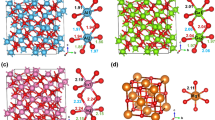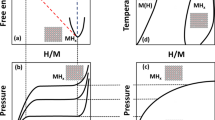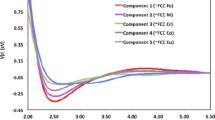Abstract
The power law regression equation, <R(M–O)> = 1.46(<ρ(r c)>/r)−0.19, relating the average experimental bond lengths, <R(M–O)>, to the average accumulation of the electron density at the bond critical point, <ρ(r c)>, between bonded pairs of metal and oxygen atoms (r is the row number of the M atom), determined at ambient conditions for oxide crystals, is similar to the regression equation R(M–O) = 1.41(ρ(r c)/r)−0.21 determined for three perovskite crystals at pressures as high as 80 GPa. The pair are also comparable with the equation <R(M–O)> = 1.43(<s>/r)−0.21 determined for oxide crystals at ambient conditions and <R(M–O)> = 1.39(<s>/r)−0.22 determined for geometry-optimized hydroxyacid molecules that relate the geometry-optimized bond lengths to the average Pauling bond strength, <s>, for the M–O bonded interactions. On the basis of the correspondence between the equations relating <ρ(r c)> and <s> with bond length, it seems plausible that the Pauling bond strength might serve a rough estimate of the accumulation of the electron density between M–O bonded pairs of atoms. Similar expressions, relating bond length and bond strength hold for fluoride, nitride and sulfide molecules and crystals. The similarity of the expressions for the crystals and molecules is compelling evidence that molecular and crystalline M–O bonded interactions are intrinsically related. The value of <ρ(r c)> = r[(1.41)/<R(M–O)>]4.76 determined for the average bond length for a given coordination polyhedron closely matches the Pauling’s electrostatic bond strength reaching each the coordinating anions of the coordinated polyhedron. Despite the relative simplicity of the expression, it appears to be more general in its application in that it holds for the bulk of the M–O bonded pairs of atoms of the periodic table.




Similar content being viewed by others
References
Alkorta I, Rozas I, Elguero J (1998) Bond length electron density relationships: from covalent bonds to hydrogen bond interactions. Struct Chem 9(4):243–247
Altermatt D, Brown ID (1985) The automatic searching for chemical bonds in inorganic crystal structures. Acta Crystallogr B 41:240–244
Bader RFW (1990) Atoms in molecules. Oxford Science Publications, Oxford
Bader RFW (2009) Bond paths are not chemical bonds. J Phys Chem A 113(38):10391–10396
Bartelmehs KL, Gibbs GV, Boisen MB (1989) Bond-length and bonded-radii variations in sulfide molecules and crystals containing main-group elements; a comparison with oxides. Am Mineral 74(5–6):620–626
Baur WH (1970) Bond length variation and distorted coordination polyhedra in inorganic crystals. Transactions of the american crystallographic association, 6, pp 129–154. American Crystallographic Association
Boisen MB, Gibbs GV, Zhang ZG (1988) Resonance bond numbers: a graph-theoretic study of bond length variations in silicate crystals. Phys Chem Minerals 15(4):409–415
Bragg WL (1937) Atomic structure of minerals. Cornell University Press, Ithaca
Brown ID (2002) Topology and chemistry. Struct Chem 13(3–4):339–355
Brown ID, Shannon RD (1973) Empirical bond-strength-bond-length curves for oxides. Acta Crystallogr A 29(3):266–282
Buterakos LA, Gibbs GV, Boisen MB (1992) Bond length variation in hydronitride molecules and nitride crystals. Phys Chem Minerals 19(2):127–132
Byström A, Wilhelmi KA (1951) The crystal structure of (NH4)2Cr2O7. Acta Chem Scand 5:1003–1010
Castillo N, Robertson KN, Choi SC, Boyd RJ, Knop O (2008) Bond length and the electron density at the bond critical point: X–X, Z–Z, and C–Z bonds (X = Li–F, Z = Na–Cl). J Comput Chem 29(3):367–379
Clark JR, Appleman DE, Papike JJ (1969) Crystal-chemical characterization of clinopyroxenes based on eight new refinements. In: Papike JJ (ed) Msa special paper no. 2, pp 31–50
Demaison J, Császár AG (2012) Equilibrium co bond lengths. J Mol Struct 1023:7–14
Donnay G, Allmann R (1970) How to recognize O2−, OH−, and H2O in crystal structures determined by x-ray. Am Mineral 55:1003–1015
Downs RT, Gibbs GV, Boisen MB Jr, Rosso KM (2002) A comparison of procrystal and ab initio model representations of the electron-density distributions of minerals. Phys Chem Minerals 29(5):369–385
Gatti C (1997) Topond96 user’s manual. CNR-CSRSRC, Milano
Gibbs GV (1982) Molecules as models for bonding in silicates. Am Mineral 67(5–6):421–450
Gibbs GV, Boisen MB, Beverly LL, Rosso KM (2001) A computational quantum chemical study of the bonded interactions in earth materials and structurally and chemically related molecules. In: Cygan RT, Kubicki JD (eds) Molecular modeling theory: applications in the geosciences, 42. Mineralogical Society of America, Washington, DC, pp 345–381
Gibbs GV, Cox DF, Rosso KM (2004) A connection between empirical bond strength and the localization of the electron density at the bond critical points of the Si-O bonds in silicates. J Phys Chem A 108(38):7643–7645
Gibbs GV, Cox DF, Rosso KM, Kirfel A, Lippmann T, Blaha P, Schwarz K (2005) Experimental and theoretical bond critical point properties for model electron density distributions for earth materials. Phys Chem Minerals 32(2):114–125
Gibbs GV, Downs RT, Cox DF, Ross NL, Prewitt CT, Rosso KM, Lippmann T, Kirfel A (2008a) Bonded interactions and the crystal chemistry of minerals: A review. Z Kristallogr 223:1–40
Gibbs GV, Downs RT, Cox DF, Rosso KM, Ross NL, Kirfel A, Lippmann T, Morgenroth W, Crawford TD (2008b) Experimental bond critical point and local energy density properties determined for Mn–O, Fe–O, and Co–O bonded interactions for tephroite, Mn2SiO4, fayalite, Fe2SiO4, and Co2SiO4 olivine and selected organic metal complexes: Comparison with properties calculated for non-transition and transition metal m-o bonded interactions for silicates and oxides. J Phys Chem A 112(37):8811–8823
Gibbs GV, Finger LW, Boisen MB (1987) Molecular mimicry of the bond length-bond strength variations in oxide crystals. Phys Chem Minerals 14(4):327–331
Gibbs GV, Ross NL, Cox DF, Rosso KM, Iversen BB, Spackman MA (2013) Bonded radii and the contraction of the electron density of the oxygen atom by bonded interactions. J Phys Chem A 117(7):1632–1640
Gibbs GV, Spackman MA, Boisen MB (1992) Bonded and promolecule radii for molecules and crystals. Am Mineral 77(7–8):741–750
Gibbs GV, Wang D, Hin C, Ross NL, Cox DF, Crawford TD, Spackman MA, Angel RJ (2012) Properties of atoms under pressure: bonded interactions of the atoms in three perovskites. J Chem Phys 137(16):164313
Gibbs GV, Whitten AE, Spackman MA, Stimpfl M, Downs RT, Carducci MD (2003) An exploration of theoretical and experimental electron density distributions and Si O bonded interactions for the silica polymorph coesite. J Phys Chem B 107(47):12996–13006
Hoffmann R (1988) Solids and surfaces: a chemist’s view of bonding in extended structures. VCH Publishers, Inc., New York, p 142
Knop O, Boyd RJ, Choi SC (1988) S–S bond lengths, or can a bond length be estimated from a single parameter. J Am Chem Soc 110(22):7299–7301
Nicoll JS, Gibbs GV, Boisen MB, Downs RT, Bartelmehs KL (1994) Bond length and radii variations in fluoride and oxide molecules and crystals. Phys Chem Minerals 20(8):617–624
Parr RG, Yang W (1989) Density-functional theory of atoms and molecules. Oxford University Press, Oxford, p 333
Pauling L (1929) The principles determining the crystal structure of complex ionic crystals. J Am Chem Soc 51:1010–1026
Pauling L (1947) Atomic radii and interatomic distances in metals. J Am Chem Soc 69(3):542–553
Pauling L (1948) The modern theory of valency. J Chem Soc (Resumed) 0(0):1461–1467
Pauling L (1960) The nature of the chemical bond and the structure of molecules and crystals: an introduction to modern structural chemistry. Cornell University Press, Ithaca
Saunders VR, Dovesi R, Roetti C, Causa M, Harrison NM, Orlando R, Apra E (1998) Crystal98 user’s manual. University of Torino, Torino
Shannon RD (1976) Revised effective ionic radii and systematic studies of interatomic distances in halides and chalcogenides. Acta Crystallogr A 32(5):751–767
Shannon RD, Prewitt CT (1969) Effective ionic radii in oxides and fluorides. Acta Cryst B25:925–946
Slater JC (1965) Quantum theory of molecules and solids: symmetry and energy bands in crystals. McGraw Hill, Inc., New York
Smith JV (1953) Reexamination of the crystal structure of melilite. Am Mineral 38:643–661
Smith VH, Absar I (1977) Basic concepts of quantum chemistry for electron density studies. Isr J Chem 16(2–3):87–102
Wang W-P, Parr RG (1977) Statistical atomic models with piecewise exponentially decaying electron densities. Phys Rev A 16(3):891
Zachariasen WH (1954) Crystal chemical studies of the 5f-series of elements. XXIII. On the crystal chemistry of uranyl compounds and of related compounds of transuranic elements. Acta Crystallogr 7:795–799
Zachariasen WH, Plettinger HA (1959) Crystal chemical studies of the 5f-series of elements. XXV. The crystal structure of sodium uranyl acetate. Acta Crystallogr 12:526–530
Acknowledgments
The work was supported in part by the National Science Foundation and the U.S. Department of Energy through grants to N.L.R. (Grant Nos. EAR-0738692 and EAR-1118691) and D.F.C. (Grant No. DEFG02-97ER14751). K.M.R. acknowledges support from US Department of Energy (DOE), Office of Basic Energy Sciences, Chemical Sciences, Geosciences and Biosciences Division. The bulk of this study was supported by a Virginia Tech University Distinguished Professor Virginia Travel Grant to G.V.G. together with a Jack Phillips Bequeath for generous support during his visit and collaboration with Mark Spackman at the School of Chemistry and Biochemistry, University of Western Australia in Australia and travel support from the Danish National Research Foundation for his visit and to participate in a symposium at the Department of Chemistry, Aarhus University in Denmark and his collaboration with Bo Iversen. G.V.G. also wishes to thank Prof. Vladimir Tsirelson, Head of the Quantum Chemistry Department at the Mendeleev University of Chemical Technology, Miusskaya, Moscow, Russia for bringing to his attention that the electron density distribution between the bonded carbon atoms of diamond is consistent with a power law rather than a exponential law relationship. Finally, we wish to thank the two reviewers of the manuscript who made a number of very important suggestions that definitely improved the manuscript. We are particularly grateful to Frank Hawthorne for suggesting a number of important changes in the text. The paper reads much better because of the reviewer’s efforts and suggestions.
Author information
Authors and Affiliations
Corresponding author
Rights and permissions
About this article
Cite this article
Gibbs, G.V., Ross, N.L., Cox, D.F. et al. Pauling bond strength, bond length and electron density distribution. Phys Chem Minerals 41, 17–25 (2014). https://doi.org/10.1007/s00269-013-0619-z
Received:
Accepted:
Published:
Issue Date:
DOI: https://doi.org/10.1007/s00269-013-0619-z




